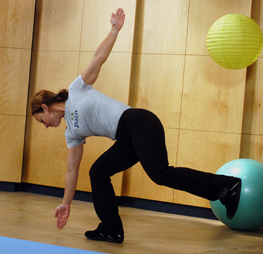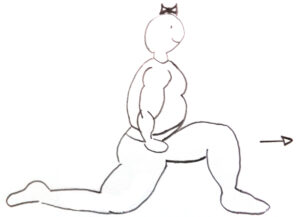 We are always striving for balance in our lives – work/life balance, balance in our relationships and in our diets. Achieving balance is tough and of course no one can have a perfectly balanced life all of the time. But the important thing is that we take the step toward balance in all areas of our lives and continue to make small gains on a daily basis. Taking a balanced approach to your diet means understanding a bit about nutrition, and experimenting and having fun with a variety of foods.
We are always striving for balance in our lives – work/life balance, balance in our relationships and in our diets. Achieving balance is tough and of course no one can have a perfectly balanced life all of the time. But the important thing is that we take the step toward balance in all areas of our lives and continue to make small gains on a daily basis. Taking a balanced approach to your diet means understanding a bit about nutrition, and experimenting and having fun with a variety of foods.
Every 5 years the Departments of Agriculture (USDA) and Health and Human Services (HHS) work jointly to provide updated dietary guidelines for Americans. On January 31, 2011, they released the newest guidelines based on Americans current eating habits. The 2010 Dietary Guidelines recommendations encompass two over-arching concepts:
1) Maintain calorie balance over time to achieve and sustain a healthy weight.
2) Focus on consuming nutrient-dense foods and beverages.
Within these concepts the guidelines encourage balancing calories to manage weight, building healthy eating patterns, helping Americans make healthy choices, and providing widespread knowledge and tips on food/nutrients to increase and those food components to reduce. But how does this translate into your everyday diet and how can you make sure that you are eating in a balanced way each day?
Here are 9 tips from these new guidelines to help create a balanced eating pattern as well as two great recipes to start you off:
1) Increase vegetable and fruit intake.
2) Eat a variety of vegetables, especially dark-green and red and orange vegetables, beans and peas.
3) Consume at least half of all grains as whole grains. Increase whole-grain intake by replacing refined grains with whole grains.
4) Increase intake of fat-free or low-fat milk and milk products, such as milk, yogurt, cheese, or fortified soy beverages.
5) Choose a variety of protein foods, which include seafood, lean meat and poultry, eggs, beans and peas, soy products, and unsalted nuts and seeds.
6) Increase the amount and variety of seafood consumed by choosing seafood in place of some meat and poultry.
7) Replace protein foods that are higher in solid fats with choices that are lower in solid fats and calories and/or are sources of oils.
8) Use oils to replace solid fats where possible.
9) Choose foods that provide more potassium, dietary fiber, calcium, and vitamin D, which are nutrients of concern in American diets. These foods include vegetables, fruits, whole grains, milk and milk products.
A great way to ensure that you are eating in a balanced way during Winter’s dark days is to investigate stews. They can be an excellent way to combine healthy vegetables, lean meats and great grains. Pair these with a small green salad and a small fruit plate for dessert and you are in good shape for your balanced meal!
Beef, Vegetable and Wild Mushroom Stew
 • 1/4 cup extra-virgin olive oil
• 1/4 cup extra-virgin olive oil
• 1 3/4- to 1-pound cross-cut meaty beef shank bone
• 1 1/2 pounds boneless beef chuck, cut into 1-inch cubes
• 2 tablespoons chopped fresh thyme, divided
• 3 bay leaves
• 2 cups chopped onions
• 1 1/2 cups diced celery
• 5 1/2 cups beef broth
• 2 14.5-ounce cans diced tomatoes in juice
• 1 large carrot, peeled, diced
• 1 large parsnip, peeled, diced
• 2 1/2-ounce packages dried porcini mushrooms
Preparation
Heat oil in large pot over medium-high heat. Add shank bone and meat cubes to pot. Sprinkle with salt and pepper. Sauté until meat is brown and juices are reduced to glaze, turning shank bone occasionally, about 15 minutes. Add 1 1/2 tablespoons thyme and bay leaves to pot; stir 1 minute. Add onions and celery; stir 3 minutes. Add beef broth, tomatoes with juice, carrot, parsnip, and mushrooms. Bring soup to boil. Reduce heat to medium-low, cover, and cook until beef is tender, about 1 hour 10 minutes. Discard shank bone and bay leaves. Season soup to taste with salt and pepper. Ladle into bowls. Sprinkle soup with remaining 1/2 tablespoon thyme and serve.
Curried Lentil and Spinach Stew
• 2 tablespoons olive oil
• 1 1/2 cups chopped onion
• 1 cup chopped celery
• 1 cup chopped peeled carrots
• 3 garlic cloves, minced
• 1 tablespoon curry powder (preferably Madras-style)
• 1 tablespoon minced fresh ginger
• 1 teaspoon ground cumin
• 1 bay leaf
• 1/4 teaspoon dried crushed red pepper
• 9 1/2 cups (or more) water
• 1 16-ounce bag dried lentils (about 2 1/2 cups)
• 1 6-ounce bag baby spinach leaves
• 1/2 cup chopped fresh cilantro
• 1/2 cup plain nonfat yogurt
 Preparation
Preparation
Heat oil in heavy large pot over medium-high heat. Add next 4 ingredients; sauté until golden, about 10 minutes. Stir in curry powder, ginger, cumin, bay leaf, and dried crushed red pepper. Add 9 1/2 cups water and dried lentils; bring to boil. Reduce heat to medium-low and simmer uncovered until lentils are tender, adding more water by 1/2 cupfuls to thin soup, if desired, about 25 minutes. Add spinach and cilantro; simmer until spinach is wilted, about 5 minutes. Season soup with salt and pepper. (Can be made 1 day ahead. Chill soup uncovered until cold, then cover and keep refrigerated. Rewarm soup over medium heat, thinning with water if desired before serving.) Ladle soup into bowls. Top each serving with spoonful of yogurt.












